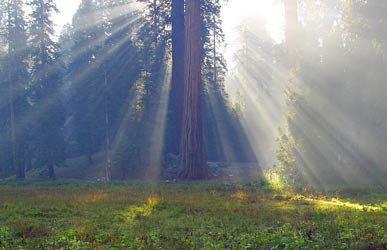The campsite is an important part of the camping or backpacking experience. A good campsite can contribute much to a great trip.. and a poor campsite will cause problems. It's helpful to know what to look for when choosing campsites so here are some campsite selection tips to help you on your way. Remember... good campsites are found, not made.
Finding a good campsite begins at home when you are planning your trip
- Contact the land management agency for the area where you plan to camp to check for camping regulations or permit requirements.
- Ask about availability of established campsites or check your map for symbols that indicate established campsites.
- If established campsites aren't available then you will have to choose a site for yourself.
- Some sites can't accommodate large group sizes so you may have to split up.
- Many areas have maximum group size regulations so plan ahead.
Most campsites are compromises of the "perfect campsite".
A good campsite will have minimum impact on the environment, let you enjoy your surroundings, will allow you to relax, and will be safe.
A good campsite will have minimum impact on the environment, let you enjoy your surroundings, will allow you to relax, and will be safe.

Choose a campsite that will have minimum impact on the environment
- Practice low-impact camping.
- Set your tent on a durable surface like rock, bare ground, sand, or gravel to protect fragile areas.
- Camp at established campsites when possible.
- Camp at least 200 feet away from water.
- Good campsites are found, not made!!!
- If fires are permitted keep them small and use only OFFICIAL fire rings or a fire pan according to area rules.
- Campsites can sometimes be closed because of past abuse.
Low-impact camping will not only protect the environment from harm,
but will ensure that there will still be quality campsites out there
but will ensure that there will still be quality campsites out there
for future campers.
A good campsite will have a clearing for your tent that is on relatively flat, well-drained terrain
- Ground that has a slight rise will help to avoid puddles in case of rain.
- You want a campsite that has some elevation and not in a depression.
Pick a campsite that will let you relax
- Scenic views are nice. There are few things more relaxing than soaking in a beautiful landscape. Some need a scenic overlook, waterfall, some just need to be surrounded by trees to relax.
- For privacy and to be courteous of others, choose a site away from trails and out of view of other campers.
- Many areas have regulations on how close to trails and scenic areas you can camp.
- Morning sun will dry tents and warm you up. Afternoon shade will shield you from the hot sun.
- Avoid areas heavy with mosquitoes and other insects.
- Mosquitoes like low marshy places, still water, tall grass, and bracken fern.
- Breezes can keep down insect numbers. Keep windward of mosquito holes. They travel with the wind not against it.
- Avoid tall grassy meadows because chiggers, ticks, ants, and other bugs live there.
When choosing your campsite make sure that it is safe.
- In rocky terrain beware of snake-infested ledges.
- Avoid areas known for avalanches and rock slides.
- Don't camp at the bottom of cliffs with loose or falling rocks.
- Camp over the high-water mark in dry stream beds or river canyons subject to flash floods.
- Beware of areas that have lots of poison ivy or oak.
- Don't camp under "widow makers" (fallen trees leaning on other trees) or threatening limbs.
- Natural wind blocks like large boulders, rock outcroppings, or dense stands of trees protect against high winds.
- Tall, dominant trees and single trees or small clumps of trees are targets for lightening.
- Dense stands of trees, all the same height, in a relatively low area, away from water offer the best protection from lightening
Misc Tips to help you Choose a Campsite
- Breezes blow up canyons or mountains during the day, and down at night.
- Hollows and valleys are usually the wettest, coldest, and foggiest spots around.
- If you camp near a mountain steam, cold air travels down water corridors and settles in low places.
- Cold air collects in meadows.
- When winter camping, don't set your tent or build a fire under trees that have snow on their branches.
Campsites are definitely a special part of the camping experience. Proper trip planning is very important and can make or break your camping trips. Know the regulations of the area and plan your camps accordingly. Have a relaxed schedule when backpacking because you will not always get the campsites that you want. Have a backup plan and always have alternate established campsites to choose from. Proper planning will save you from having to settle for a campsite that is far from ideal. When we are prepared and are in a relaxed state we are less likely to leave a negative impact. When we are happy and enjoying a backpacking trip any good site can become our "perfect campsite".


No comments:
Post a Comment